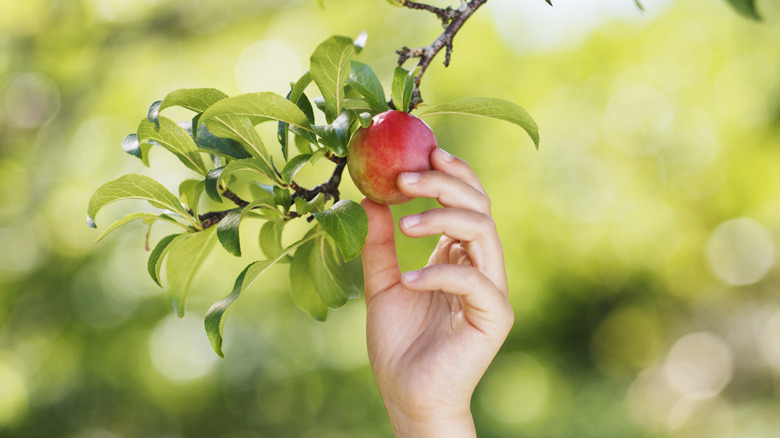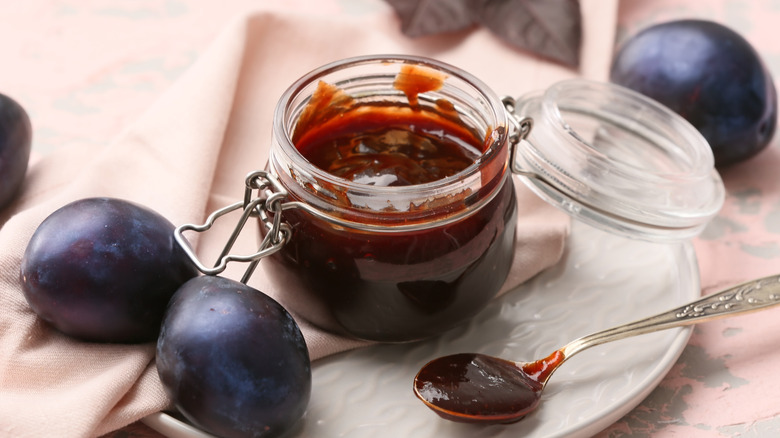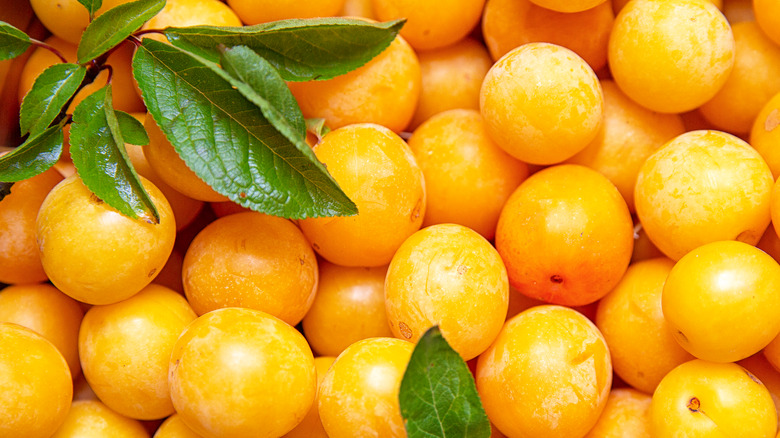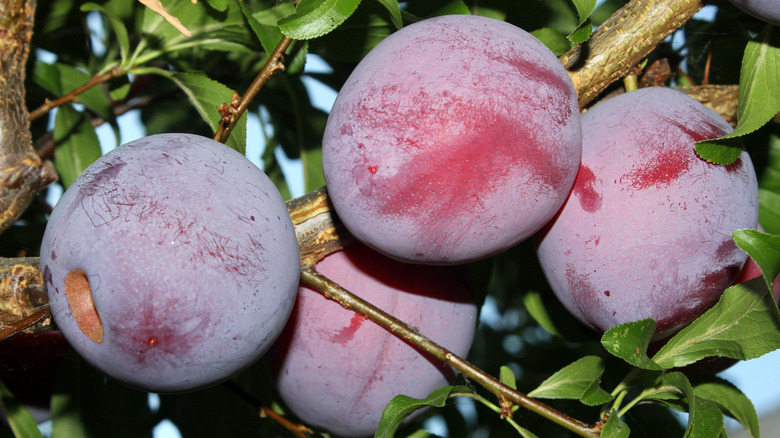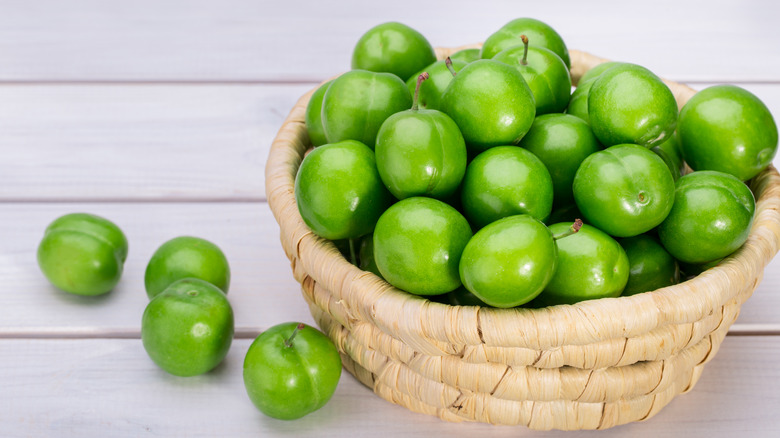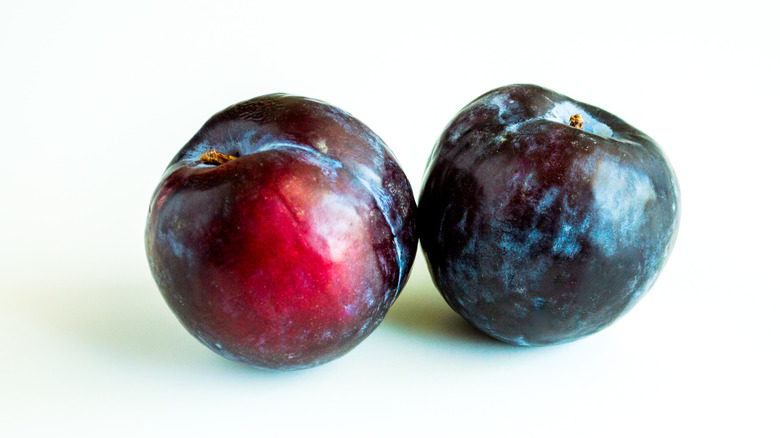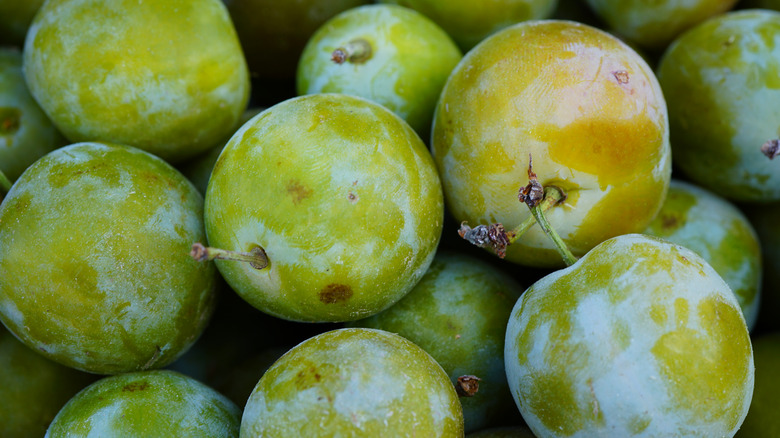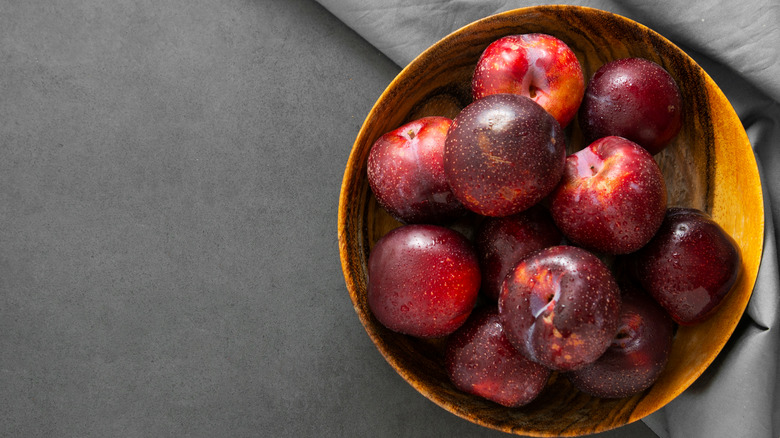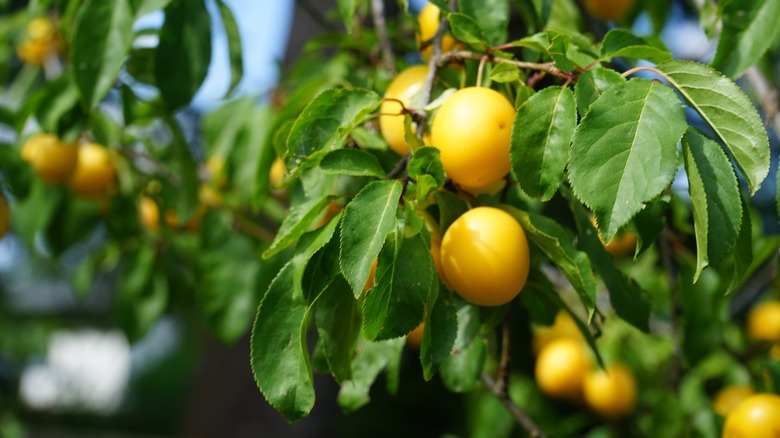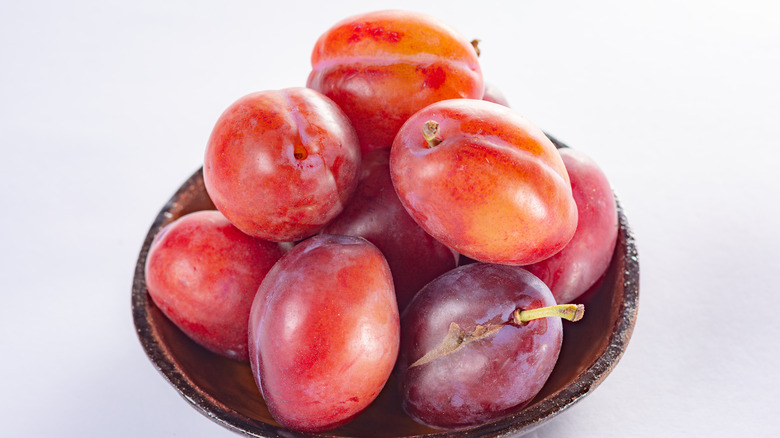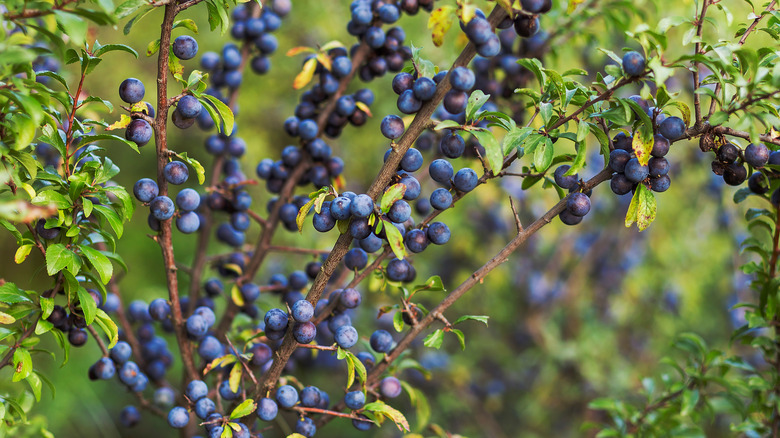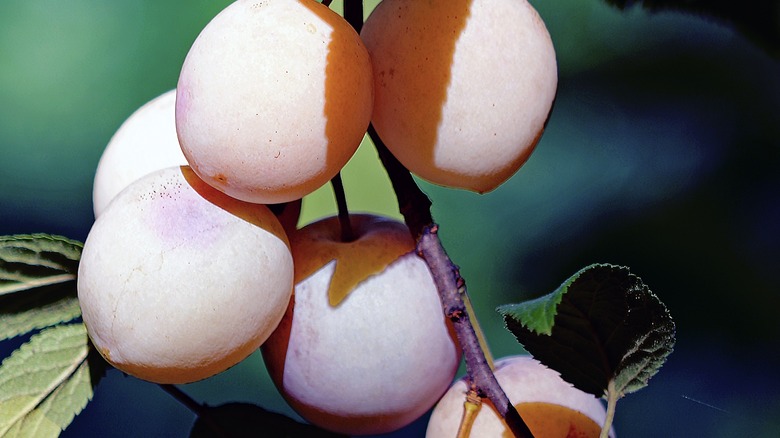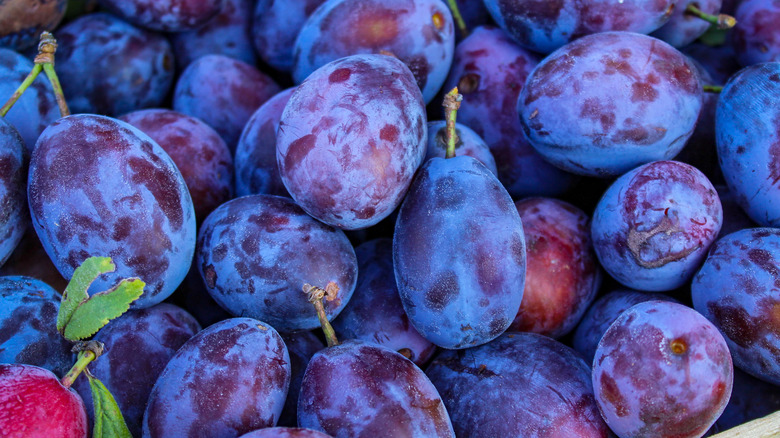12 Types Of Plums And What Makes Them Unique
Plums always pack a punch. With a sweet, fleshy inside and a tart, edible peel, these stone fruits are delightfully delicious, fresh, or dried as a standalone snack. They also add a zing to sweet and savory culinary creations alike. Desserts like plum-lavender pie are a perfect way to round out dinner. And plums add depth and flavor to meatier dishes like pork chops. Closely a stone fruit relative, plums are high in fiber and vitamins, low in calories, and can be found in most supermarkets year-round (via Healthline).
Hobby Farms writes that plums were one of the first fruits ever domesticated by humans in China over 2,000 years ago. Today, most of the world's plums come from China, though they're available around the globe. While wild plums have been growing on the east coast of the United States since before settlers arrived in North America, most of the plums we eat today originated from the Japanese and European varieties (via Encyclopedia Britannica).
You're probably familiar with a few varieties of plums available at most grocery stores. Still, you may be surprised to learn that there are dozens of different kinds of plums, each with a distinct color, shape, and flavor profile. In this article, we'll dig into plums that range from purple to yellow to deep crimson and span the spectrum of sweetness to reveal what makes each plum unique.
Damson Plum
There's a new superfood in town: the damson plum. Purple fruits like blackberries and blueberries are well-known superfoods because they contain a high concentration of compounds that greatly benefit the human body (via Everyday Health). Damson plums have a color similar to blueberries. They are very high in nutrients, antioxidants, and anthocyanins, which have been linked to health benefits that include anti-cancer and anti-diabetic properties, according to the Riddet Institute.
Ancient writings suggest that the damson plum was first cultivated in the region around Damascus and brought to Europe by the Romans, where it was used to make dye because of its deep purple skin, as reported by Encyclopedia Britannica. Often overlooked in favor of other larger, sweeter varieties of plum, the damson is not usually eaten fresh off the tree because it has a slightly bitter, astringent flavor. But make no mistake, this sweet-sour flavor makes them perfect for jams, jellies, and desserts. They're also a popular choice for making a distinctive plum brandy called slivovitz, which is popular in Central and Eastern Europe and is often served after meals as a digestif (via Delighted Cooking).
Mirabelle Plum
This sweet French plum, almost impossible to find in the U.S., enjoys a star status in the Lorraine region of France — where the vast majority of these small, exceptionally sweet golden-yellow fruits are produced. And these tasty morsels are as elusive as they are delightful. French Moments classifies that they have a short harvest season that lasts only from mid-August through September, and once ripe; the mirabelle is difficult to transport because it has a soft, delicate body that bruises easily. In fact, these plums are so prized that the Lorrainian town of Metz throws a mirabelle Plum Festival for two days every August that attracts over 80,000 visitors a year and ends with the election of the Mirabelle Plum Queen (via France Voyage).
Though mirabelles are petite compared to other varieties, the trees are very productive, growing a high yield of fruit that ensures there will be leftovers after the queen is crowned (via Raintree Nursery). This is good news because they're delicious for baking. mirabelle plum tarts, pies, cakes, and galettes are perfect ways to celebrate the end of summer — if you can get your hands on them.
Santa Rosa Plum
The Santa Rosa plum is named after its hometown of Santa Rosa, California. According to Good Fruit Grower, it was developed by famed horticulturist Luther Burbank, who crossed seeds that he imported from Japan with other plums to create a powerhouse fruit that dominated the commercial market in California from 1945 until the mid-1970s, when the Friar plum overtook it.
The American Society for Horticultural Studies writes that this plum was bred to have reddish flesh like a satsuma fruit with the density and acidity of an apricot. Still much beloved by growers, this variety has a sweet taste that is more orange along the edges and delightfully tart purple skin (via Arbor Day Foundation). While Santa Rosas are great to eat fresh off the tree, you can also use them in sugary confections or take advantage of their sweet, tangy taste to balance out the flavor of a chicken tagine or a pork roast.
Persian Sour Plum
If the words "sour" and "crunchy" don't come to mind when you think of plums, you're certainly not alone. Plums are supposed to be sweet and soft, right? Not the Persian sour plum. As detailed by Cricket Hill Garden, these tart and tiny morsels are usually picked before they're ripe and crunch like a crisp apple when you bite into them, although they eventually turn sweet and golden if left to ripen on the tree.
The Persian sour is native to Iran and especially popular in the northern city of Tabriz, where they're often associated with the celebration of the Persian new year, which coincides with the Spring equinox, per Paradise Nursery. The Persian sour plum is mouthwateringly juicy, and as Specialty Produce writes, it is often eaten from the tree with a dusting of salt, chili powder, or dipped in shrimp paste to round out the sour flavor profile. The famous little fruit also features heavily in favorites of northern Persian cuisine like Koofteh Tabrizi, which are meatballs cooked in a rich tomato sauce and stuffed with hard-boiled egg, herbs, spices, and, you guessed it: plums.
Friar Plum
Chances are you're already acquainted with the friar plum whether you know it or not. They have deep red to black skin, a small pit, and tasty, sweet, golden-yellow flesh. Sound familiar? The friar is one of many Japanese plum varieties, which according to Encyclopedia Britannica, are generally known to have a longer shelf life than their European counterparts. Friars are more plump and juicy and bloom earlier
With a hearty body, a long growing season, and crack-resistant skin, friar plums are very attractive to commercial growers, per Dave Wilson Nursery. In fact, in the 1980s, the friar overtook the Santa Rosa plum as the most popular plum in California, which produces over 90% of the plums grown in the United States (via the University of California Agriculture and Natural Resources). That means they're easy to find in the produce aisle at most supermarkets, which is great news because these large, hearty plums make a perfect snack when they're eaten fresh and can also be canned or made into jam.
Greengage Plum
If you've got a sweet tooth, you need to look no further than the greengage plum. On the Brix scale, which measures the sugar content of the fruit, the greengage scores a whopping 30-38, meaning that the water inside is about 40% sugar per Minnetonka Orchards. And don't be deceived by the green skin, which makes this smaller-than-average variety look unripe to the untrained eye. In a piece for The New York Times, journalist David Karp wrote that, during his childhood, he "would pluck as many as I could, and their syrupy sweetness inspired a rapture that has haunted me ever since, though the tree died long ago."
Originally descended from the Reine-Claude Doree, a sugary French plum fit for a queen, the greengage was named after gardener Sir William Gage, who cultivated the fruit when it was brought to his native England. After making its way to North America in the 18th century, it fell out of favor because soft fruits are delicate and difficult to transport. Today, only a handful of orchards in the United States produce green Gages, according to The Los Angeles Times. If you're lucky enough to come upon a greengage, don't even think about making it into a jam or a pie. These rare, syrupy treats are best enjoyed fresh off the tree.
Satsuma Plum
The satsuma is one of several varieties of "blood plum," so called because the tart, reddish-purple peel encases juicy, ruby-red flesh (via Fruit Salad Trees). It was originally given the somewhat spooky name "The Blood Plum of Satsuma," but there's no reason to be squeamish regarding this plump, juicy fruit. The UC Davis College of Agriculture writes that satsumas were originally imported to California from Yokohama, Japan, in the late 1800s, and they thrive in the state's temperate southern region because of an aversion to cold temperatures. Because of their popularity and abundance, these plums are easy to find in the United States, where they are available at many grocery stores or online from sites like Fresh Direct.
If you're planning on dessert, you can make a plum cake on the grill, and using satsumas adds an extra splash of color that makes this sweet treat look particularly appetizing. It's also never a mistake to eat a satsuma plum straight off the tree, although you should think about having a napkin handy as the deep red juice dribbling down your chin can leave you looking like a vampire.
Myrobalan Plum
The myrobalan is not the kind of plum you're used to. While most plums we buy from the supermarket today are Japanese or European varieties, these small, tart fruits are native to Western China and the Caucasus (via Minnetonka Orchards). They were cultivated in the region for hundreds of years but have fallen out of favor for commercial growing because of their small size and low flesh-to-pit ratio. In fact, they're sometimes called cherry plums because they're hardly larger than the average cherry.
While they might be hard to find at the store, you can often find myrobalans growing on the side of the road or on the edge of a forest, where they're planted as ornamental trees and prized for their beautiful flowers, according to Food Forest. Each tree produces a huge amount of fruit, and if you can get your hands on a couple of pounds of these tart, round, yellow fruits, they're great for making a cherry plum wine, as well as jams and syrups. Per Flora Obscura, they still figure heavily in Georgian cuisine, used in soups, stews, and sauces.
Victoria Plum
God Save the Victoria plum! Named in honor of Her Majesty the Queen of England, this egg-shaped plum is the most common variety in the United Kingdom, per Orange Pippin. Introduced in the 1840s, the Victoria plum now enjoys an iconic status in the United Kingdom, where it is widely grown commercially and in private gardens.
But buyer beware: Gardening Know How reports that the Victoria plums found in the produce section of grocery stores are often sold before they are fully ripe when they boast a distinctive orange-pink hue the color of a sunset. An unripe plum isn't a problem if you're planning on using them to make jam, a popular use for these softly colored beauties. Slightly unripe fruits are higher in pectin and natural acid, so you don't need to use lemon juice or jam sugar to help the jam set. And it's only natural to use Victoria plum jam for another royally named British delicacy: the Victoria Sandwich. However, if you're planning on enjoying these fresh plums, look for those with dark, reddish-purple skin.
Sloe Plum
The sloe plum is not for the faint of heart. Also known as blackthorns, these small, dark fruits aren't usually eaten off the tree because they have a strong astringent taste, and, according to House Digest, they contain amygdalin, which can be toxic to humans in large doses. But what they lack in sweetness, they make up for in legend and lore. In the telling of Irish folktales, fairies reside in blackthorn bushes.
There are, however, many uses for the Sloe plum beyond spooky campfire stories. The thorny bushes that produce sloe plums are often used as hedges in gardens and bloom with beautiful, creamy-white flowers in the spring and, per alternative sites like Health From Nature, the sloe plum can "have a soothing and relaxing effect on stomach inflammations." Rochelt, an artisanal Tyrolean distillery in the Austrian Alps, makes a sloe plum fruit brandy, and its tart, tangy flavor profile makes them perfect for jellies, syrups, and liqueurs. In some regions in France, they're pickled like olives and eaten out of the jar.
Wild Goose Plum
Put on your boots and grab your basket because these rare little plums are almost exclusively collected in the wild. Native to midwestern North America, the wild goose plum was one of several wild plums cultivated by indigenous people east of the Mississippi River before the arrival of European settlers, per the blog Indigenous Landscapes.
Per Oikos, this small, sweet plum has yellow flesh and thick skin that ranges from maroon to orangey pink. Wild goose plum trees yield very little fruit, and if you do happen to find some, they're not best eaten off the tree because the skin is usually quite bitter. That said, these rare gems strike a combination of tart and sweet that makes for a perfectly balanced jam, though there's not enough of them to serve grilled or in other fresh preparations. Some people believe that the compounds found in this rare little plum have medicinal properties ranging from stimulating respiration to improving digestion (via Natural Medicinal Herbs).
French Prune Plum
The humble prune has a less-than-glamorous reputation in the United States. But it's about time that changed because, according to WebMD, prunes have high levels of antioxidants and anti-inflammatory properties in addition to their well-known fiber content that aids in digestion. Enter the French Prune plum.
Before the invention of the refrigerator in France, these dark purple plums were dried to provide people with sugary, nutritious snacks that provided a burst of energy during the winter months (via Trees of Antiquity). In fact, they were so sought after that prunes were used to bargain wages in the 15th century. French prune trees were brought to California during the Gold Rush in the mid-1800s, where they continue to thrive to this day. Although these famed French fruits are perfect for making dried prunes with which to top salads, eat as a snack, or turn into a dessert, they are also sweet enough to be eaten right off the tree. And, while they work perfectly for baking sweet treats, the most fun use of French prunes might be fermenting them into a delightfully tangy liqueur (via Minnetonka Orchards).
